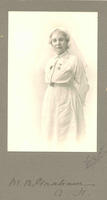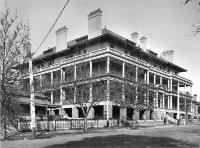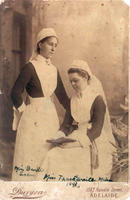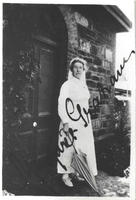
South Australian Medical Heritage Society Inc
Website for the Virtual Museum
Home
Coming meetings
Past meetings
About the Society
Main Galleries
Medicine
Surgery
Anaesthesia
X-rays
Hospitals,other organisations
Individuals of note
Small Galleries
Ethnic medicine
- Aboriginal
- Chinese
- Mediterran
A Nurse Called Margaret Graham
Acknowledgement:
We are most grateful to Dr. Joan Durdin AM. FRCNA. DUniv, who
allowed us to publish her presentation "A Nurse Called Margaret Graham". She is a noted
historian, author and educator. She received her Honorary Doctorate from Flinders University in
1994.
Who was Margaret Graham? To people who have been associated with the Royal Adelaide Hospital the name 'Margaret Graham' should be familiar, being the name of an elegant building in Frome Road. It is one of many sturdy structures that make up the present-day public hospital. This building was completed in 1911 and was first known as 'The Nurses Home'. In 1953 a second Nurses Home was built alongside it. To distinguish the two, the authorities deemed that the buildings would be named Nurses Home Number One and Nurses Home Number Two.
A group of senior members of the Royal Adelaide Hospital Nurses Association considered that the buildings should have more distinguished names and wrote to the Board of Management, asking that the buildings be named in honour of Misses Margaret Graham and Eleanor Harrald.1 The two women were nursing probationers at the Adelaide Hospital in the early 1890's and both rose to the rank of matron. When the Board of Management failed to accede to the Association's request its president sought an interview with the Minister of Health, Sir Lyell McEwin, and won his approval of the proposal. The buildings are so named to this day. So, who was Margaret Graham?
Margaret Graham's nursing career was particularly distinguished and lasted for nearly thirty years. Born in Carlisle, in the north of England in 1860,2 where her father was a journeyman painter, she came to Adelaide in 1891 and enrolled as a probationer nurse at the Adelaide Hospital in May of that year.3 Between 1895 and 1898 she was associated with an infamous disturbance contemporarily known as 'The Hospital Row'. To tell her story it is helpful look back to learn what was happening at the hospital, and in particular in the nursing sphere, in the latter years of the nineteenth century.
Until 1889 no matron of the Adelaide Hospital had a formal education in nursing. There were already nurse training programs in one or two hospitals in Sydney and Melbourne, following the appointment of matrons recommended by Florence Nightingale, but not at the Adelaide Hospital. In South Australia, Parliamentary Enquiries in the 1860's and again in the 1870's revealed that all was not well with the hospital's nursing service. In 1888 the housekeeper, a worthy lady but not a nurse, was pressed into service as the matron. Later that year the hospital's Board of Management was delighted to receive enquiries from two English nurses, Misses Maud Thackthwaite and Margaret Burke, who had come to Australia with good credentials from the matron of The London Hospital.4 The Board offered Miss Thackthwaite the post of Matron, and her companion the post of Deputy and Senior Night Sister. They took up their appointments on February 1, 1889.5
There was at that time a nursing staff of 27 – a matron, 9 charge nurses of varying lengths of experience (nurses who had charge of wards) and 17 nurses who were classified as probationers, but were appointed before any formal nursing training program was offered. The average bed occupancy for 1889 was 181 patients.6
The annual report of 1889 noted an increase in expenditure, and attributed this to numerous alterations and improvements, including furnishing and re-stocking the twelve wards and greater liberality of the diet scale. It also noted that in connection with the improved system of nursing no difficulties had arisen in securing a sufficient number of probationers for the nursing staff. The matron gave regular lectures to the nurses. Among the nurses appointed by Miss Thackthwaite were three whose names were associated, a few years later, with an unfortunate disturbance in the smooth operation of the nursing service. They were Misses Louisa Hawkins, appointed in October 1890, Miss Hannah Gordon, appointed in November of that year, and Miss Margaret Graham, appointed in May 1891.
The Board was disappointed when Misses Thackthwaite and Burke decided not to renew their contracts at the end of 1891. For their replacement it sought the assistance of the Agent-General for South Australia, in London. This resulted in applications from two more nurses from the London Hospital, Misses Rosa Banks and Pauline Chapple. Both came to Adelaide to take up appointments, but Miss Chapple resigned a year later. Her place was taken by another English nurse, Miss Robina McLeod. Miss Banks, as Matron and Superintendent of Nurses, continued the good work begun by Miss Thackthwaite. Under her supervision Nurses Hawkins, Gordon and Graham completed the three year course of training and all three progressed to the rank of Charge Nurse.
Little is known of Margaret Graham's life as a probationer, but one document provides evidence of her concern for women's rights. The early 1890's were marked by the rising interest of South Australian women in their right to vote in parliamentary elections. Hundreds of women signed a petition seeking this privilege. Among the 11,600 signatures on the petition for womens' suffrage, presented to parliament in August 1894, are those of three nurses at the Adelaide Hospital, including Margaret Graham.
Before noting some of changes in nursing leadership at the Adelaide Hospital in the mid-1890's, the relationship between the hospital's Board of Management and the Government can be considered. The Government's hope for a voluntary hospital, such as those in Great Britain, had never materialized. It made regular appeals for donations from citizens, but the Adelaide Hospital continued to depend to a large extent on government funding. At this time the Chief Secretary, The Hon. John Gordon, had ministerial responsibility for the hospital. The Premier was Charles Cameron Kingston. Later political commentators contend that Kingston, a Progressive Liberal, was a fiery character, ever ready to become involved in controversies.7 One area in which he asserted himself over the next few years was the management of the Adelaide Hospital. The events that followed indicate one outcome of this interest.
Towards the end of 1894, at the end of her three-year term as matron, Miss Banks hoped that her contract would be renewed, but for reasons that it did not record, the Board did not renew it and Miss Banks resigned. The Chief Secretary advised the Board that the vacancy should be filled from among the existing staff, at a salary of £100 per annum, which was £20 less than that of the former matron. Ignoring the instruction to make an internal appointment, the Board advertised more widely and received, among others, the application of Miss Thackthwaite, who was still in Australia. However, although offered the post, Miss Thackthwaite refused to accept it at the lower salary. Without further advertising the Board then appointed Miss McLeod, the Senior Night Sister, as Matron.
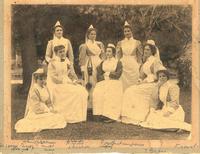
To fill Night Sister vacancy the Medical Superintendent, Dr Perks, recommended the appointment of Miss Hannah Gordon, a relatively junior Charge Nurse. At this, eight charge nurses, including Misses Hawkins and Graham, protested on the grounds that others who were senior to Miss Gordon were overlooked. Some correspondence appearing in the Press at this time supported the nurses, and imputed the charge of nepotism, as Miss Gordon was the sister of the Chief Secretary. The Board of Management of the Hospital heard the nurses' protests and considered them to be disrespectful and intemperate. It appointed a special committee to enquire into the matter and demand apologies. Six of the nurses complied, but Nurses Graham and Hawkins refused. The Board suspended them from duty.8 Removed from the restraint of the hospital Graham engaged in further criticism of the Board.
The Chief Secretary was in a difficult position due to his relationship to the nominee and he referred the recommendation for the post of Senior Night Sister to the Premier. The Government entered into the fray, and correspondence in the press abounded. It included correspondence from Margaret Graham, critical of the hospital Board. The Government called a Royal Commission to enquire into the management of the hospital. Supporters of the Board alleged that the members of the Commission had been selected because they were favourably disposed towards the nurses. The Commission found that there was no basis to support Miss Graham's charges against the Board, but concluded that the nurses had been justified in protesting.
The Government then notified the Board that Nurses Graham and Hawkins were to be re-instated but the Board refused, on the grounds that re-instatement would destroy discipline and harmonious working within the hospital. The Government insisted on the re-instatement of Margaret Graham. It also notified the Board that its services were to be dispensed with at the end of February 1896. Within a few weeks the Medical Superintendent, the Matron, Miss McLeod, and Miss Gordon all resigned in support of the Board.
In February 1896 the Government appointed a new Board which took up its role in March. However, before the Board was installed, the Premier acted to secure Miss Graham's re-appointment as a charge nurse. This contributed to the disaffection of the doctors, and resulted in the resignation of the honorary medical staff of the Hospital.
Closure of the Medical School was an outcome, and formal relations between the hospital and the University were in disarray until after the turn of the century.
Minutes of Board meetings do not reveal much in regard to the nursing service in the next two years. Miss Susan Lane, who had been a charge nurse at the Hospital since 1889 and was now senior to other charge nurses, was appointed Matron to fill the vacancy left by Miss McLeod's departure. She occupied this post until December 1897, when she too resigned. The Board wished to advertise in other colonies for her replacement but the Government insisted on the policy of first seeking an appointment from among existing members of the nursing staff. Only one application was received – that of Margaret Graham. She had been a charge nurse since her re-instatement nearly two years earlier. She took up the position of Matron on 1 January 1898, on an annual salary of £120.
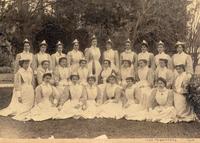
The first few years of Miss Graham's appointment must have been difficult, for there was a level of resistance, not least among the medical staff, while members of the new Board of Management were wary of the new Matron. There was a sense of insecurity among the charge nurses also, some of whom resigned. Finding replacements was not easy and more resignations ensued. A study of the Minutes of Board Meetings gives the impression that Miss Graham was required to attend Board meetings frequently to justify her objections to nursing staff appointments to which she had no initial input. Other matters for which the Board took responsibility without discussion with the Matron were recommendations for changes to hours of duty, disciplinary matters, and others of a more domestic nature, such as adjustments to nurses' uniforms.
Despite what must have seemed deliberate disregard of her authority as leader of the nursing service, Miss Graham pressed on. She soon found an opportunity for an important step in the interest of recognition of nursing standards. The Royal British Nurses Association had been established in Britain in 1887, at a time when nursing leaders throughout that country were beginning to form associations to strengthen their hands in taking responsibility for their profession. In 1900 Margaret Graham received an invitation from the RBNA to consider establishment of a branch in South Australia. This she did with vigour. She was appointed its Lady Consul, a role that she fulfilled between 1900 and 1920. Most of the nurse members had completed their training at the Adelaide Hospital. The regulation requiring applicants to have completed nursing training at a general hospital of more than 40 beds precluded nurses from other new training schools at smaller hospitals in South Australia from membership. By 1905 nurses from these training schools were being encouraged by their matrons to join another association, the newly established branch of the Australasian Trained Nurses Association, set up in NSW in 1899. Both organizations applied themselves to setting standards for nursing training in the days before the State Government took over this function.9
From its earliest years, the Royal British Nurses Association in South Australia made provision for doctors to become members. Early annual reports show that many medical men supported nurses in this way. Some served on its Board of Management.
In another direction, the Royal British Nurses Association secured vice-regal patronage when Lady Tennyson, wife of the Governor of South Australia, agreed to fill this role. This brought Margaret Graham into prominence at the time of the visit to South Australia of the Duke and Duchess of York. Apparently without reference to the Hospital Board, Miss Graham made arrangements with Lady Tennyson for members of the RBNA to be presented to the Duchess on the occasion of Royal visit to the hospital in 1901. Subsequently the Board rebuked the Matron for her action.
Meanwhile Margaret Graham's influence was spreading in other directions. In 1901 the new Commonwealth Government established an Army Nursing Reserve. In South Australia Miss Graham was appointed as its first Lady Superintendent in 1904.10 Other former Adelaide Hospital nurses also became members of the Reserve. The role did not make great demands on their time. All were required to attend a course of lectures on the organization of the military hospital, hygiene, and military surgery, for which proficiency certificates were awarded. For some of them, including Margaret Graham, this led in 1914 to full time overseas service with the Australian Army Nursing Service.11
Whereas Margaret Graham's relationships with the Board of Management of the Adelaide Hospital were cool, she formed more effective relationships with her nurses, many of whom testified to their regard for her readiness to listen to their complaints, and to her justice. An unfortunate situation arose in 1911, which, in contrast to the 'Hospital Row' of the 1890's, did not extend into the public arena to the same extent. Nevertheless it prompted a headline in the Adelaide newspaper The Register, which read "Nurses' grievances – Trouble at the Adelaide Hospital – Objections to a sister", and brought Miss Graham into conflict with the Board again.12 The problem began when three nurses approached the matron to report their refusal to work in a ward under the direction of a particular Charge Nurse. Miss Graham was aware of the charge nurse's "acid tongue" and was sympathetic to the nurses, but urged them to return to the ward. As other vacancies to the ward staff occurred, a succession of nurses refused the order to work there. A group of nurses took their complaint to the Board, which conducted an inquiry. Determined to maintain discipline, the Board suspended the first three nurses, leading to a protest signed by a great majority of the probationers. The Matron upheld the nurses' action, but to no avail. Three young women were dismissed. Miss Graham privately tried to find alternative nursing positions for them, but they did not complete their training. The two ring-leaders of the protest, senior nurses, were punished by the temporary withholding of their award of gold medals.
In 1914 the Board may have been relieved to receive from Margaret Graham a request for leave to proceed overseas on active duty with the Australian Army Nursing Service. As Lady Superintendent of the Nursing Reserve in the Fourth Military District, she was appointed with the rank of Matron, and sailed for Egypt in October 1914. She served for four years in hospitals in Egypt, on hospitals ships, and in Britain. She was mentioned in dispatches in 1916, and in 1917 received the international award of the Royal Red Cross.
On her return to Adelaide in August 1918, the colony was in the grip of the influenza pandemic. In January 1919 Miss Graham was transferred temporarily to take charge of nursing at the emergency hospital which had been set up in the former Exhibition Building on Frome Road. Sadly her deputy, the faithful Miss Edith Williams, died of influenza in May of that year. She was a contemporary of Margaret Graham, and had been a nurse at the Adelaide Hospital for nearly 30 years. She was in charge of the nursing service during the four years of Miss Graham's war service.
Miss Eleanor Harrald was appointed to take charge of nursing at the Adelaide Hospital until Miss Graham's return after closure of the Influenza Hospital. She succeeded her as Matron when Margaret Graham retired at the end of 1920. In 1921 Miss Graham returned to her former home in the north of England, where nursing associates from the Adelaide Hospital visited her when they travelled to England during the last 20 years of her life. She died at Carlisle on 4 July 1942 at the age of 82.
Assessments of the work of Margaret Graham include a laconic statement in the Board of Management's annual report for 1921. Brief and non-committal, it reads: "Miss Graham resigned her position after serving very many years to the satisfaction of the Board of Management". Another is in an entry in Volume 9 of the Australian Dictionary of Biography.13 It's writer summarises the career of the nursing leader in the following terms: "Margaret Graham was a spirited, forthright, highly intelligent woman with a ready wit and strong leadership qualities. During her matronship nearly 3,000 nurses came under her care and she won the esteem and affection of most of them".
It is not surprising that in 1953, more than thirty years after Margaret Graham's retirement and twelve years after death, former nurses at the Royal Adelaide Hospital took determined steps to ensure that her name was perpetuated on the hospital site. The Margaret Graham building still stands, a worthy reminder of a highly regarded nursing leader.
Joan Durdin
March 2014
Footnotes:
- Records of RAH Registered Nurses Association, correspondence 1953/1954, RAH Archives.
- Copy of birth certificate in RAH Heritage Office.
- 'Appointments to Staff 1888 – 1925', RAH Heritage Office.
- Durdin, J. Eleven Thousand Nurses : A History of Nursing Education at the Royal Adelaide Hospital, 18.
- 'Appointments to Staff 1888 – 1925', RAH Heritage Office.
- Annual Report, Board of Management, Adelaide Hospital, 1890.
- Robert van den Hoorn and John Playford, 'The Adelaide Hospital Row' in The Flinders Political History of South Australia, p. 215, 216.
- The date of Graham's suspension is noted in the 'Register of Appointments' as 1/3/95, and her re-instatement as 4/3/96.
- The Nurses Act made provision for regulation of nursing standards in 1920.
- Commonwealth Gazette, 1904.
- A.G. Butler, The Australian Army Medical Service in the War of 1914-1918, Australian War Museum 1943, 535.
- Durdin, Joan, Eleven Thousand Nurses: A History of Nursing Education at the Royal Adelaide Hospital, 1999, p 47-50.
- Lincoln, M. In: Australian Dictionary of Biography, volume 9, p 68.
-o0o-
